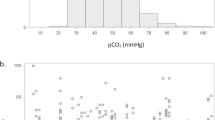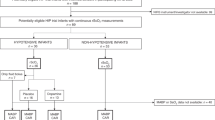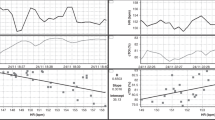Abstract
Objective:
To evaluate cerebrovascular autoregulation as a function of arterial blood pressure (ABP) in the critically ill, premature infant.
Study Design:
A prospective observational pilot study was conducted in two tertiary care Neonatal Intensive-Care Units. Premature infants (n=23, ⩽30 weeks estimated gestational age with invasive ABP monitoring) were enrolled and received routine care while undergoing continuous autoregulation monitoring, using the cerebral oximetry index (COx). The COx is a moving, linear correlation coefficient between cortical reflectance oximetry and ABP. COx values were stratified as a function of ABP for individual subject recordings and for the cohort.
Result:
The mean duration of autoregulation monitoring was 3.2 days (median: 2.97, range: 0.61–3.99). A total of 10 of 23 (43%) developed intraventricular hemorrhage and 1 of 23 (4%) developed periventricular leukomalacia by head ultrasound. No association was found between neurologic injury and percentage of the monitoring periods with autoregulation impairment (defined as COx>0.5). Lower ABP was associated with dysautoregulation (higher COx values, P<0.01). The percentage of time with impaired autoregulation was greater with lower ABP (P=0.013, Spearman r=0.51).
Conclusion:
All infants studied had periods with intact and periods with impaired cerebrovascular autoregulation, measured with the COx. Low ABP was associated with impaired autoregulation.
This is a preview of subscription content, access via your institution
Access options
Subscribe to this journal
Receive 12 print issues and online access
$259.00 per year
only $21.58 per issue
Buy this article
- Purchase on Springer Link
- Instant access to full article PDF
Prices may be subject to local taxes which are calculated during checkout




Similar content being viewed by others
References
Gronlund JU, Korvenranta H, Kero P, Jalonen J, Valimaki IA . Elevated arterial blood pressure is associated with peri-intraventricular haemorrhage. Eur J Pediatr 1994; 153 (11): 836–841.
Batton B, Zhu X, Fanaroff J, Kirchner HL, Berlin S, Wilson-Costello D et al. Blood pressure, anti-hypotensive therapy, and neurodevelopment in extremely preterm infants. YMPD 2009; 154: 351–357, e351.
Cordero L, Timan CJ, Waters HH, Sachs LA . Mean arterial pressures during the first 24 h of life in <or=600-gram birth weight infants. J Perinatol 2002; 22: 348–353.
Goldstein RF, Thompson RJ, Oehler JM, Brazy JE . Influence of acidosis, hypoxemia, and hypotension on neurodevelopmental outcome in very low birth weight infants. Pediatrics 1995; 95: 238–243.
Hall RW, Kronsberg SS, Barton BA, Kaiser JR, Anand KJS . Morphine, hypotension, and adverse outcomes among preterm neonates: who's to blame? Secondary results from the NEOPAIN trial. Pediatrics 2005; 115: 1351–1359.
Pellicer A, Del Carmen Bravo M, Madero R, Salas S, Quero J, Cabanas F . Early systemic hypotension and vasopressor support in low birth weight infants: impact on neurodevelopment. Pediatrics 2009; 123: 1369–1376.
Watkins AM, West CR, Cooke RW . Blood pressure and cerebral haemorrhage and ischaemia in very low birthweight infants. Early Hum Dev 1989; 19: 103–110.
Bada HS, Korones SB, Perry EH, Arheart KL, Ray JD, Pourcyrous M et al. Mean arterial blood pressure changes in premature infants and those at risk for intraventricular hemorrhage. YMPD 1990; 117: 607–614.
Brazy JE, Lewis DV, Mitnick MH, Jobsis vander Vliet FF . Noninvasive monitoring of cerebral oxygenation in preterm infants: preliminary observations. Pediatrics 1985; 75 (2): 217–225.
Jobsis FF . Non-invasive, infra-red monitoring of cerebral O2 sufficiency, bloodvolume, HbO2-Hb shifts and bloodflow. Acta neurol Scand Suppl 1977; 64 (Journal Article) 452–453.
Lee JK, Kibler KK, Benni PB, Easley RB, Czosnyka M, Smielewski P et al. Cerebrovascular reactivity measured by near-infrared spectroscopy. Stroke 2009; 40 (5): 1820–1826.
Brady KM, Lee JK, Kibler KK, Smielewski P, Czosnyka M, Easley RB et al. Continuous time-domain analysis of cerebrovascular autoregulation using near-infrared spectroscopy. Stroke 2007; 38 (10): 2818–2825.
Tsuji M, Saul JP, du Plessis A, Eichenwald E, Sobh J, Crocker R et al. Cerebral intravascular oxygenation correlates with mean arterial pressure in critically ill premature infants. Pediatrics 2000; 106: 625–632.
Soul JS, Hammer PE, Tsuji M, Saul JP, Bassan H, Limperopoulos C et al. Fluctuating pressure-passivity is common in the cerebral circulation of sick premature infants. Pediatr Res 2007; 61: 467–473.
Pellicer A, Valverde E, Elorza MD, Madero R, Gayá F, Quero J et al. Cardiovascular support for low birth weight infants and cerebral hemodynamics: a randomized, blinded, clinical trial. Pediatrics 2005; 115: 1501–1512.
Brady KM, Mytar JO, Lee JK, Cameron DE, Vricella LA, Thompson WR et al. Monitoring cerebral blood flow pressure autoregulation in pediatric patients during cardiac surgery. Stroke 2010; 41 (9): 1957–1962.
Brady KM, Shaffner DH, Lee JK, Easley RB, Smielewski P, Czosnyka M et al. Continuous monitoring of cerebrovascular pressure reactivity after traumatic brain injury in children. Pediatrics 2009; 124 (6): e1205–e1212.
Brady KM, Mytar JO, Kibler KK, Hogue Jr CW, Lee JK, Czosnyka M et al. Noninvasive autoregulation monitoring with and without intracranial pressure in the naive piglet brain. Anesth Analg 2010; 111 (1): 191–195.
McCrea HJ, Ment LR . The diagnosis, management, and postnatal prevention of intraventricular hemorrhage in the preterm neonate. Clin Perinatol 2008; 35 (4): 777–792, vii.
Linder N, Haskin O, Levit O, Klinger G, Prince T, Naor N et al. Risk factors for intraventricular hemorrhage in very low birth weight premature infants: a retrospective case-control study. Pediatrics 2003; 111 (5 Part 1): e590–e595.
Sarkar S, Bhagat I, Dechert R, Schumacher RE, Donn SM . Severe intraventricular hemorrhage in preterm infants: comparison of risk factors and short-term neonatal morbidities between grade 3 and grade 4 intraventricular hemorrhage. Am J Perinatol 2009; 26 (6): 419–424.
Florence G, Seylaz J . Rapid autoregulation of cerebral blood flow: a laser-Doppler flowmetry study. J Cereb Blood Flow Metab 1992; 12 (4): 674–680.
Aaslid R, Lindegaard KF, Sorteberg W, Nornes H . Cerebral autoregulation dynamics in humans. Stroke 1989; 20 (1): 45–52.
Ragauskas A, Daubaris G, Petkus V, Ragaisis V, Ursino M . Clinical study of continuous non-invasive cerebrovascular autoregulation monitoring in neurosurgical ICU. Acta neurochir Suppl 2005; 95 (Journal Article) 367–370.
Czosnyka M . Association between arterial and intracranial pressures. Br J Neurosurg 2000; 14 (2): 127–128.
Czosnyka M, Smielewski P, Kirkpatrick P, Menon DK, Pickard JD . Monitoring of cerebral autoregulation in head-injured patients. Stroke 1996; 27 (10): 1829–1834.
Czosnyka M, Smielewski P, Kirkpatrick P, Laing RJ, Menon D, Pickard JD . Continuous assessment of the cerebral vasomotor reactivity in head injury. Neurosurgery 1997; 41 (1): 11–17; discussion 17–19.
Wong FY, Leung TS, Austin T, Wilkinson M, Meek JH, Wyatt JS et al. Impaired autoregulation in preterm infants identified by using spatially resolved spectroscopy. Pediatrics 2008; 121: e604–e611.
O’Leary H, Gregas MC, Limperopoulos C, Zaretskaya I, Bassan H, Soul JS et al. Elevated cerebral pressure passivity is associated with prematurity-related intracranial hemorrhage. Pediatrics 2009; 124: 302–309.
Acknowledgements
Funding Support: Johns Hopkins Institute for Clinical and Translational Research—Accelerated translational incubator pilot program (ATIP) award (to K Brady), The Hartwell Foundation individual biomedical research award (to K Brady).
Author information
Authors and Affiliations
Corresponding author
Ethics declarations
Competing interests
The monitoring techniques described in this manuscript have been submitted for patent protection by Johns Hopkins University, listing K. Brady as inventor. Conflicts of interest related to these patents are managed by the Johns Hopkins University in accordance with its conflict of interest policies.
Rights and permissions
About this article
Cite this article
Gilmore, M., Stone, B., Shepard, J. et al. Relationship between cerebrovascular dysautoregulation and arterial blood pressure in the premature infant. J Perinatol 31, 722–729 (2011). https://doi.org/10.1038/jp.2011.17
Received:
Revised:
Accepted:
Published:
Issue Date:
DOI: https://doi.org/10.1038/jp.2011.17
Keywords
This article is cited by
-
Relationship of cerebral blood volume with arterial and venous flow velocities in extremely low-birth-weight infants
European Journal of Pediatrics (2023)
-
Near-infrared spectroscopy monitoring of neonatal cerebrovascular reactivity: where are we now?
Pediatric Research (2023)
-
Clinical determinants of cerebrovascular reactivity in very preterm infants during the transitional period
Pediatric Research (2022)
-
Neonatal NIRS monitoring: recommendations for data capture and review of analytics
Journal of Perinatology (2021)
-
The association between carbon dioxide, cerebral blood flow, and autoregulation in the premature infant
Journal of Perinatology (2021)



